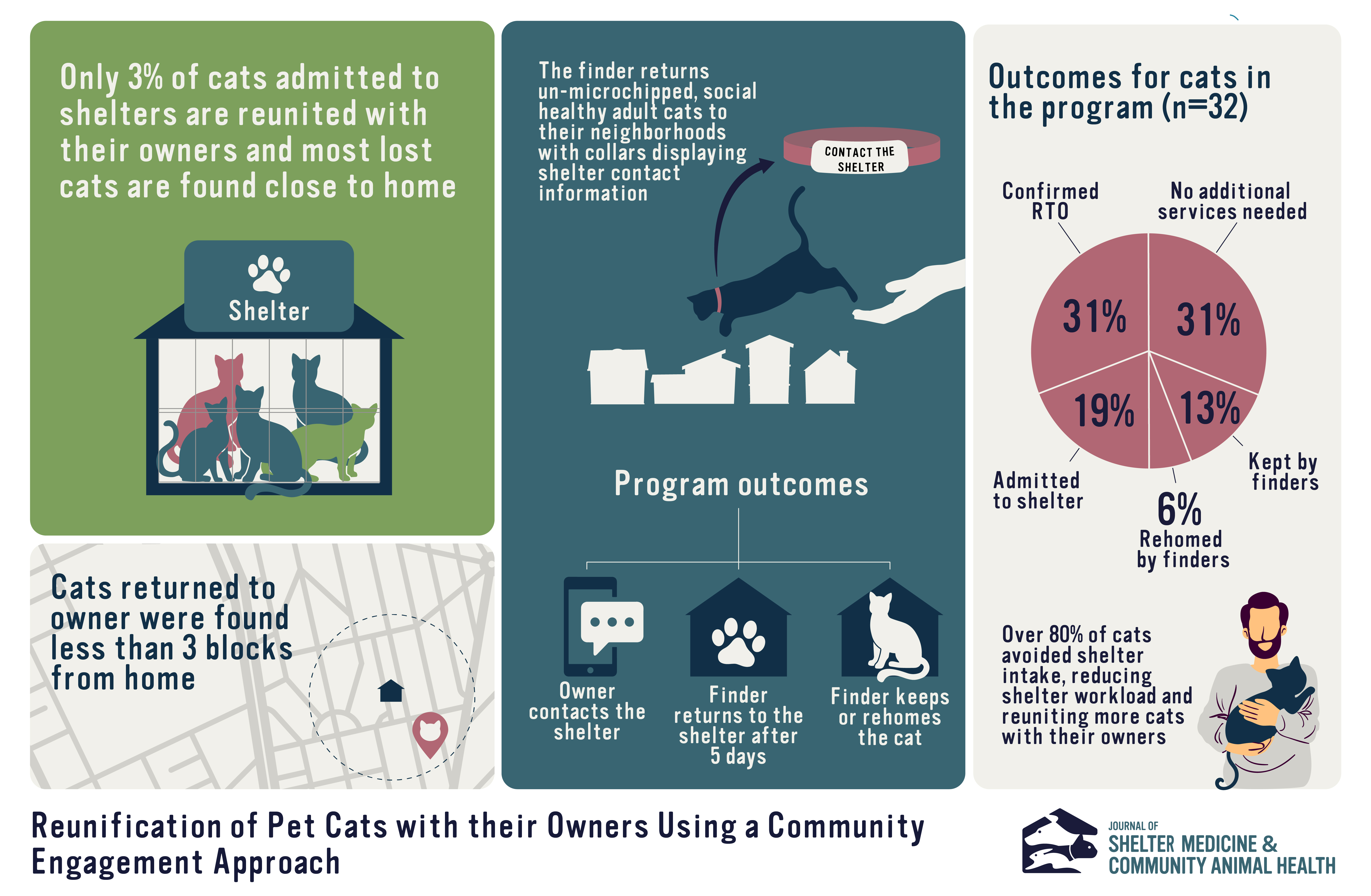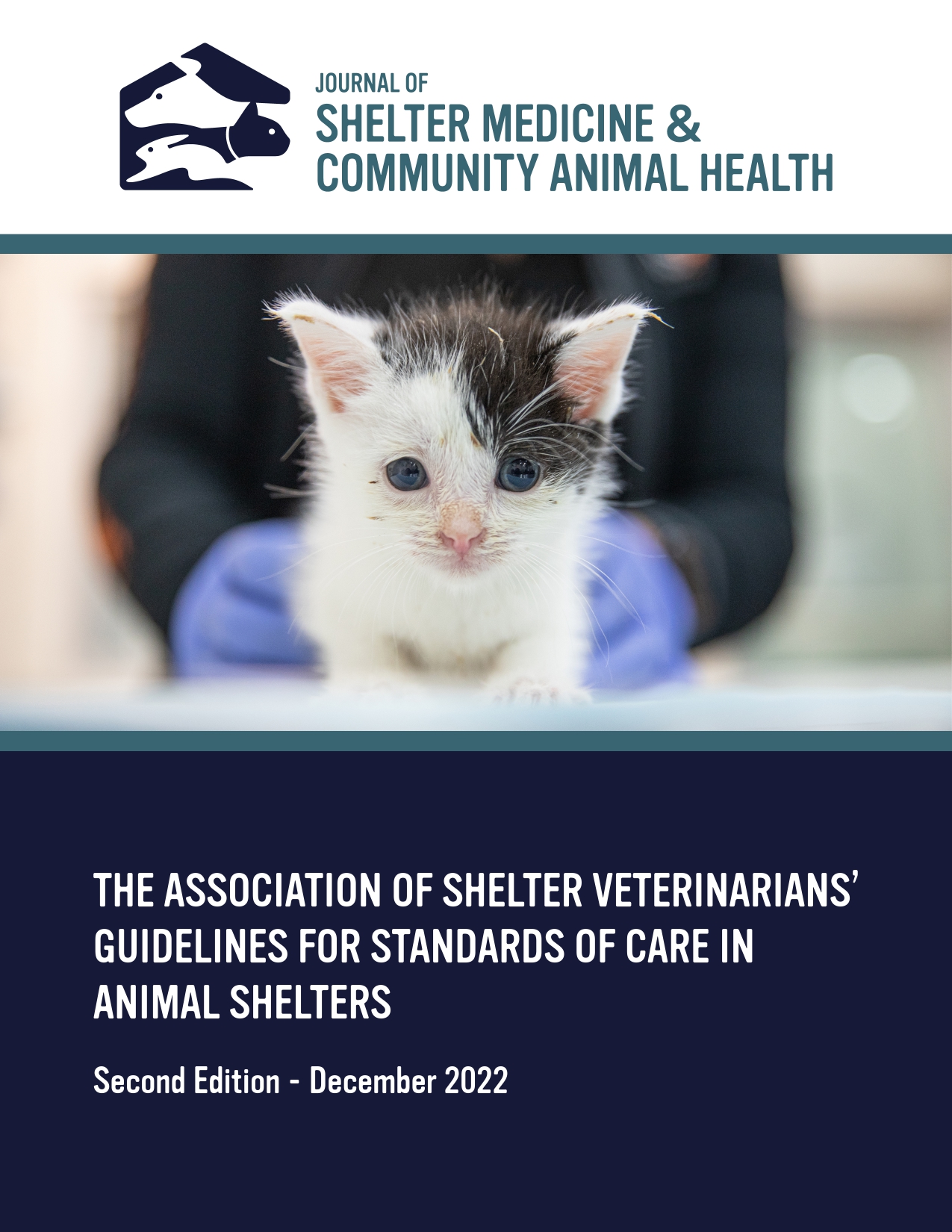Tag! You’re Home! Reunification of Pet Cats With Their Owners Using a Community Engagement Approach: A Community Case Report
DOI:
https://doi.org/10.56771/jsmcah.v3.113Keywords:
lost cat, stray cat, microchip, identification, managed intake, return to owner, return to home, community engagementAbstract
Return to Owner (RTO) rates for cats in shelters are reported as low as 5.3%. However, the percentage of recovered pet cats located within their own neighborhoods is much higher. Loudoun County Animal Services, an open-admission shelter with an annual intake of 2,300 animals (46% cats), developed the Tag! You’re Home! Program (TYHP). This program encourages finders to return un-microchipped healthy social adult cats to their neighborhoods with a collar containing the shelter’s contact information. Finders can return them for intake after 5 days. Between 7/1/2022 and 12/31/2023, 476 stray cats were admitted, 253 (53%) of which were adults. Of the 32 cats enrolled in TYHP as an alternative to intake, 31% were confirmed RTO via owner contact, 31% did not require additional services, 19% were brought back for intake, 13% were kept by finders, and 6% were rehomed by finders. For the cats admitted, the adult RTO rate was 28%. Cats returned to owners through the shelter were found a median of 0.27 km (interquartile range 0.07–2.5), or approximately 2.7 city blocks, from home. Over 80% of TYHP cats did not require shelter intake, with a 31% confirmed RTO rate. The TYHP reduced the intake of adult stray cats by 9% while maintaining similar RTO rates.
Downloads
References
1.
Lord LK, Wittum TE, Ferketich AK, Funk JA, Rajala-Schultz PJ. Search and Identification Methods that Owners Use to Find a Lost Cat. J Am Vet Med Assoc. 2007;230(2):217–220. doi: 10.2460/javma.230.2.217
2.
Tanaka A, Wagner DC, Kass PH, Hurley KF. Associations among Weight Loss, Stress, and Upper Respiratory Tract Infection in Shelter Cats. J Am Vet Med Assoc. 2012;240(5):570–576. doi: 10.2460/javma.240.5.570
3.
Dinnage JD, Scarlett JM, Richards JR. Descriptive Epidemiology of Feline Upper Respiratory Tract Disease in an Animal Shelter. J Feline Med Surg. 2009;11(10):816–825. doi: 10.1016/j.jfms.2009.03.001
4.
Weiss E, Slater M, Lord L. Frequency of Lost Dogs and Cats in the United States and the Methods Used to Locate Them. Anim Open Access J MDPI. 2012;2(2):301–315. doi: 10.3390/ani2020301
5.
Hurley KF, Levy JK. Rethinking the Animal Shelter’s Role in Free-Roaming Cat Management. Front Vet Sci. 2022;9. doi: 10.3389/fvets.2022.847081
6.
Cuccinelli Kenneth T, II, Attorney General. Official Advisory Opinion in Accordance with § 2.2-505 of the Code of Virginia. Published online July 12, 2013. https://www.oag.state.va.us/files/Opinions/2013/12-100_Napier.pdf
7.
Confinement and Disposition of Stray Animals. Vol 612. 16. https://codelibrary.amlegal.com/codes/loudouncounty/latest/loudounco_va/0-0-0-2331#JD_612.16
8.
2024 AAFP Indoor/Outdoor Lifestyle Position Statement. J Feline Med Surg. 2024;26(2):1098612X241227827. doi: 10.1177/1098612X241227827
9.
Halls V, Bessant C. Managing Cat Populations Based on an Understanding of Cat Lifestyle and Population Dynamics. J Shelter Med Community Anim Health. 2023;2(S2). doi: 10.56771/jsmcah.v2.58
10.
Tan SML, Jajou S, Stellato AC, Niel L. Perspectives of Canadian and American Cat Owners on Provision of Uncontrolled Outdoor Access for Owned Domestic Cats. Front Vet Sci. 2021;8:742245. doi: 10.3389/fvets.2021.742245
11.
Lord LK, Ingwersen W, Gray JL, Wintz DJ. Characterization of Animals with Microchips Entering Animal Shelters. J Am Vet Med Assoc. 2009;235(2):160–167. doi: 10.2460/javma.235.2.160
12.
Weiss E, Slater MR, Lord LK. Retention of provided Identification for Dogs and Cats Seen in Veterinary Clinics and Adopted from Shelters in Oklahoma City, OK, USA. Prev Vet Med. 2011;101(3):265–269. doi: 10.1016/j.prevetmed.2011.05.008
13.
Lord LK, Griffin B, Slater MR, Levy JK. Evaluation of Collars and Microchips for Visual and Permanent Identification of Pet Cats. J Am Vet Med Assoc. 2010;237(4):387–394. doi: 10.2460/javma.237.4.387
14.
Arhant C, Heizmann V, Schauberger G, Windschnurer I. Risks and Benefits of Collar Use in Cats (Felis catus); A Literature Review. J Vet Behav. 2022;55–56:35–47. doi: 10.1016/j.jveb.2022.07.012
15.
Calver MC, Adams G, Clark W, Pollock KH. Assessing the Safety of Collars Used to Attach Predation Deterrent Devices and ID Tags to Pet Cats. Anim Welf. 2013;22(1):95–105. doi: 10.7120/09627286.22.1.095
16.
Huang L, Coradini M, Rand J, et al. Search Methods Used to Locate Missing Cats and Locations Where Missing Cats Are Found. Animals. 2018;8(1):5. doi: 10.3390/ani8010005
17.
Kremer T. A New Web-Based Tool for RTO-Focused Animal Shelter Data Analysis. Front Vet Sci. 2021;8. doi: 10.3389/fvets.2021.669428
18.
Davis L, Parker K. A Half-Century after ‘Mister Rogers’ Debut, 5 Facts about Neighbors in the U.S. Pew Research Center. August 15, 2019. Accessed June 18, 2024. https://www.pewresearch.org/short-reads/2019/08/15/facts-about-neighbors-in-u-s/

Additional Files
Published
Issue
Section
License
Copyright (c) 2025 Aimee M. Dalrymple, Nina E. Stively, Rachael Kreisler

This work is licensed under a Creative Commons Attribution 4.0 International License.









